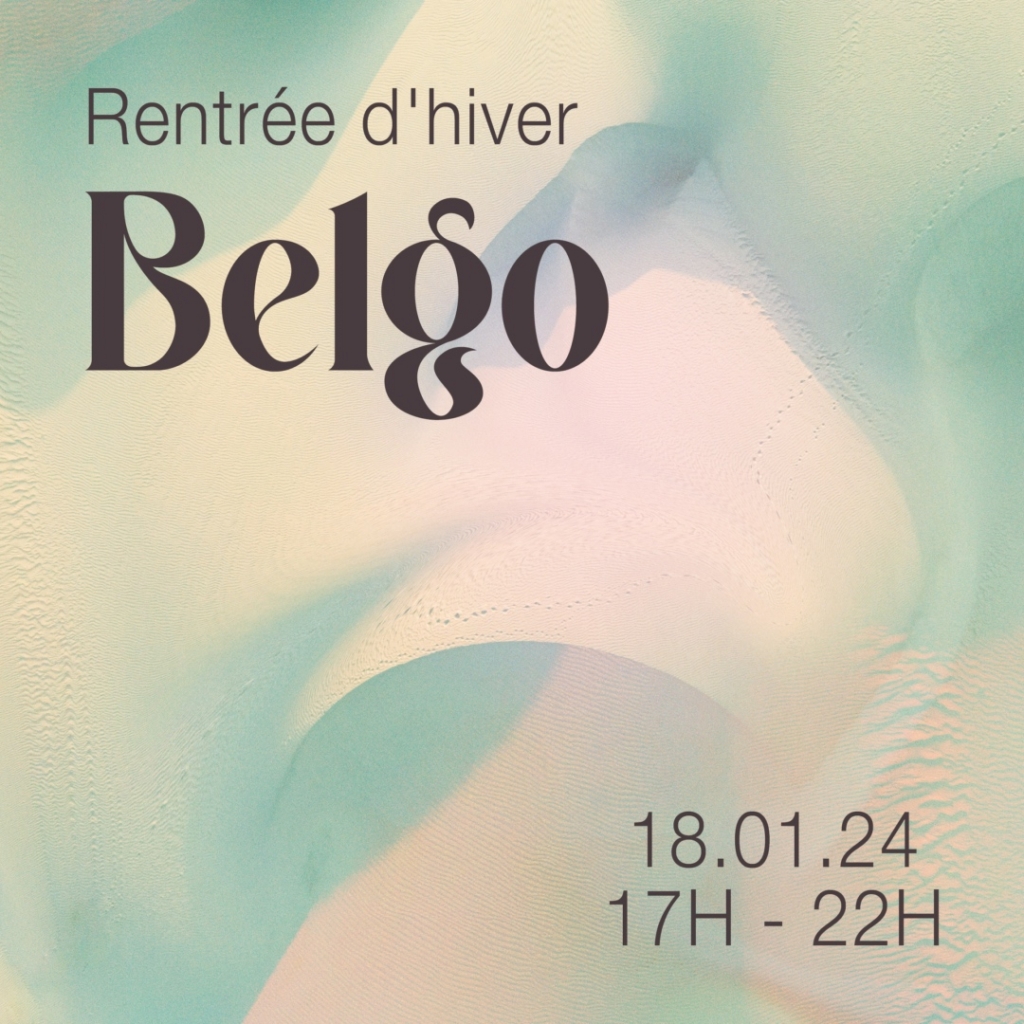
La communauté artistique du Belgo vous invite chaleureusement à sa rentrée hivernale de 2024!
De nombreuses galeries d’art, centres d’artistes, espaces d’exposition et organismes culturelles seront ouverts pour cet événement incontournable, qui rassemble une multitude d’expositions entièrement gratuites et accessibles à toutes et à tous. Plusieurs artistes exposants seront sur place, alors que nos équipes dévouées se feront un plaisir de vous accueillir dans une ambiance festive!
C’est un rendez-vous à ne pas manquer, le jeudi 18 janvier 2024 dès 17h!
— — —
The Belgo’s artistic community warmly invites you to its 2024 winter opening!
Numerous art galleries, artist centres, exhibition spaces and cultural organizations will be open for this event, bringing together a multitude of exhibitions that are entirely free and accessible to everyone. Several exhibiting artists will be present—along with the dedicated staff—to welcome you within a festive atmosphere!
An event not to be missed, Thursday January 18 from 5 p.m.!
PROGRAMMATION
314 | Centre des arts actuels Skol
Catalogue des ruines — Samuel Bernier Cormier, Lauren Chippeur, Kuh Del Rosario, Xavier Orssaud, et Elise Rasmussen
L’éponge mécanique — Ève Constantin
https://skol.ca
325 | Atelier Suárez
Atelier ouvert – Luis Fernando Suárez
instagram.com/luisfernsuarez
403 | Galerie B-312
Les galeries-logis — Pépite et Josèphe
https://galerieb312.ca
410 | Patel Brown
Susceptibility to Gravity — Alexa Kumiko Hatanaka
patelbrown.com
413 | Atelier d’art photographique
Flore — Jean-Claude Lussier
jeanclaudelussier.com
414 | McBride Contemporain
Best Friends for Never — Adrian Norvid et Marcela Szwarc
mcbridecontemporain.com
416 | Chiguer Art contemporain
Collectionner — Thierry Arcand-Bossé, Marcel Barbeau, Dan Brault, Eveline Boulva, Yves Gaucher, Pierre Gauvreau, Lise Gervais, Jacques Hurtubise, Serge Lemoyne, François Morelli, Jean-Paul Riopelle, et François Simard
chiguerartcontemporain.com
423 | Atelier Carolina Echeverría
Atelier ouvert – Carolina Echeverría
https://carolinaecheverria.ca
426 | Arprim
Cartes universelles pour voyage sédentaire — Violaine Lafortune
Et si je me permettais de briser ces silences — Myriam Tousignant
arprim.org
442 | Galerie POPOP
L’étant aimé — Raphaëlle Groulx-Julien
galeriepopopgallery.com
444 | CIRCA art actuel
KEEP IN TOUCH–Entretiens : deuxième chapitre — Cindy Dumais
Cérémonie — Xavier Orssaud
circa-art.com
502 | Galeries Bellemare Lambert
Abécédaire dentaire — Richard Purdy
Sites auriculaires — John Baldessari, Céleste Boursier-Mougenot, Ozias Leduc, Joe Lima, Christian Marclay, Tom Marioni, Peter Moore, et Maurice Ravel
bellemarelambert.com
507 | SBC Galerie d’art contemporain
Histoire(s) de territoire(s) — Jessica Houston et Laurence Butet-Roch; commissaire Sophie Bertrand
https://sbcgallery.ca
508 | Galerie Hugues Charbonneau
Chambre émeraude — Marie-Danielle Duval
Paysages parallèles — Farzaneh Rezaei
huguescharbonneau.com
521 | Espace St-Jean
Atelier ouvert – Louis-Bernard St-Jean
espacestjean.com
531 | Atelier 531
Atelier ouvert – Kara Eckler
karaeckler.com
]]>
La dynamique communauté artistique du Belgo vous convie chaleureusement à célébrer avec nous la rentrée culturelle d’automne 2023!
En tant que l’un des plus grands regroupements d’organismes dédiés aux arts contemporains à Montréal – abritant de nombreuses galeries d’art, centres d’artistes et d’exposition, ainsi qu’une variété d’organismes culturels – cet événement est une occasion exceptionnelle de plonger dans un univers de créativité et d’inspiration. Le 14 septembre prochain, de 17h à 22h, nous vous ouvrons nos portes afin de vous offrir un éventail d’expériences entièrement gratuites et accessibles à tous, en compagnie de plusieurs des artistes exposants.
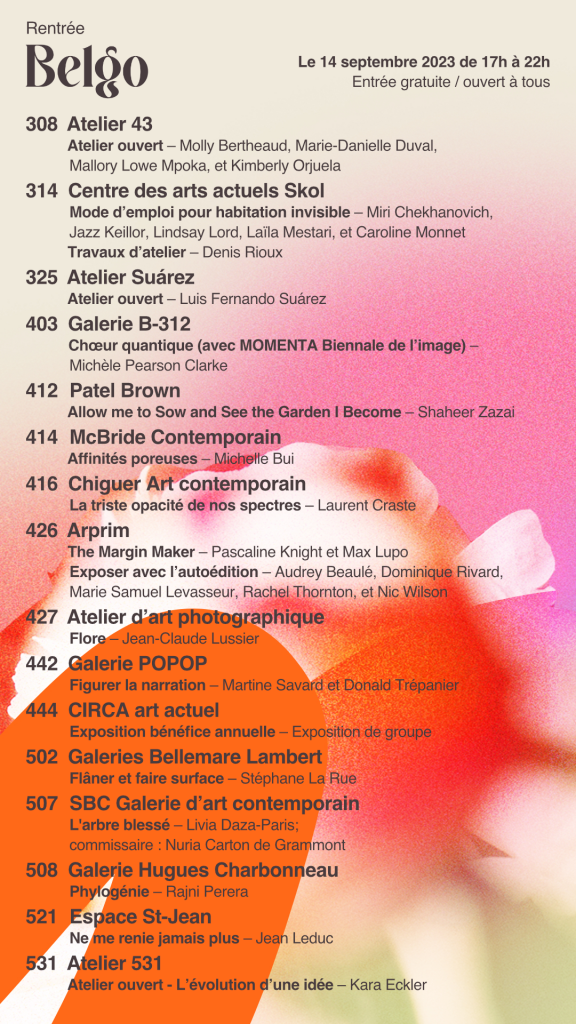
Join us in celebrating the much-awaited 2023 Fall opening of The Belgo, a cornerstone of Montreal’s vibrant artistic community!
As one of the largest gatherings of organizations dedicated to contemporary arts in Montreal – housing numerous art galleries, artist and exhibition centers, and a variety of cultural entities – this event represents an exceptional opportunity for you to immerse yourself in a world of creativity and inspiration. On September 14th, from 5:00 PM to 10:00 PM, we open our doors to offer you an array of entirely free and accessible experiences for everyone, in the company of several of the exhibiting artists.
]]>
Please click page flip button to read the next page.
]]>
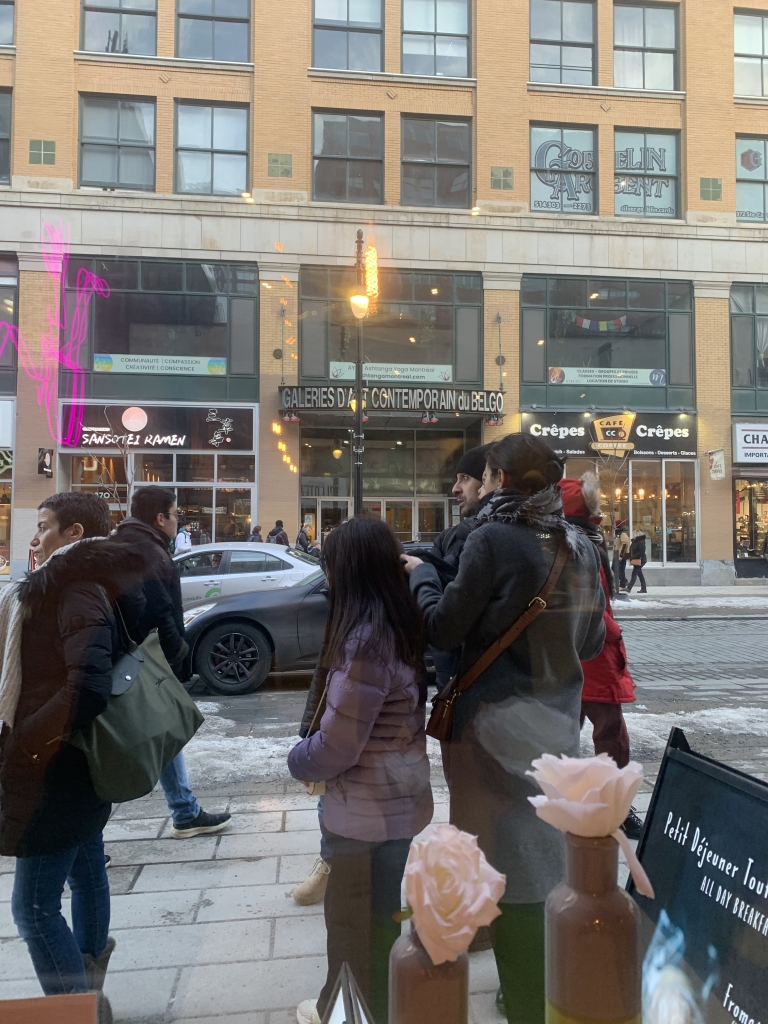
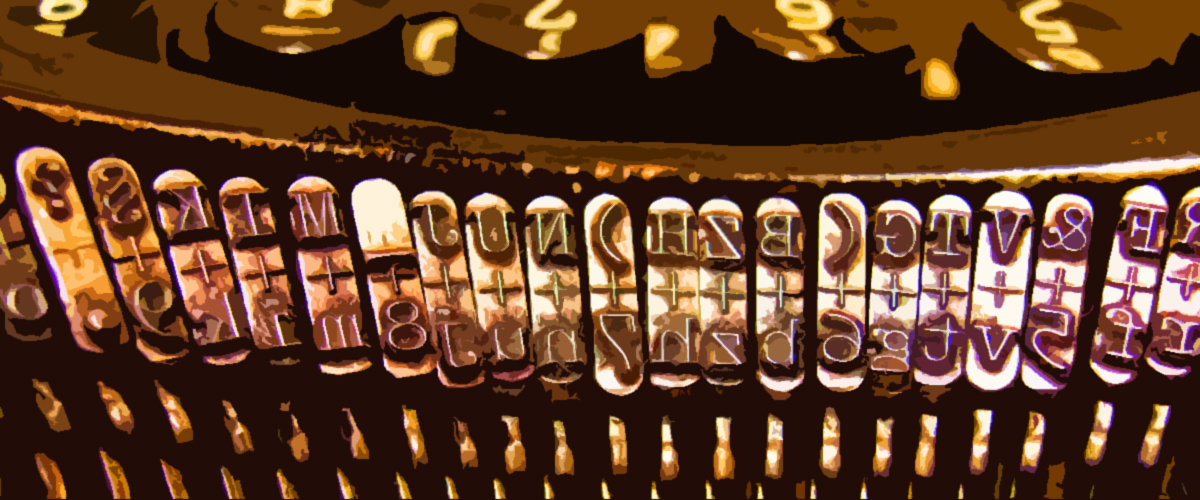
Contribute
The Belgo Report is looking for contributors.
Visual Art Reviewer (English or French)
We are looking for a regular contributor to cover visual art exhibitions and events in the Belgo building. Your articles will appear with your byline and a link back to your own blog. Your headshot and profile will be added to the About the Belgo Report page. If you are interested in becoming part of the Belgo Report team, please send a writing sample to studio@karaeckler.com
]]>
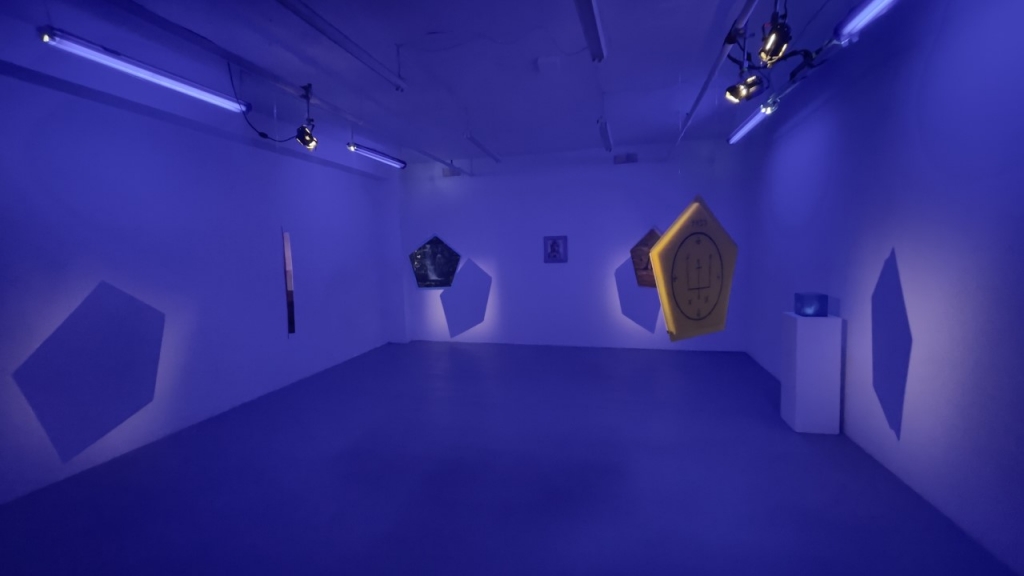
In Tabula Rasa, artist Alex Coma sets the scene of the art gallery as a sacred space for ritual. In the age of capitalism the marketplace is often presented to be our temple, and gallery spaces often serve such ends. Here, as throughout the history of art, we have spiritual intent taking precedence. Entering the exhibition, one is greeted by a pleasant violet glow cast on the majority of works from black lights, giving the exhibition an ethereal presence and a sense of altered space and perception. Hanging in the centre of Galerie Popop were four pentagonal-shaped canvases, with esoteric images on both front and back. Stepping into the middle of the quartet, one finds landscape paintings rendered with romantic and atmospheric detail, pertaining to the four elements. Upon closer inspection, the faint traces of a pentagram and magical symbols can be seen drawn under the surface of the oil painting. On the reverse, the canvases are topped with Hebrew letters, and underneath, various symbols and magical sigils. Each canvas is oriented to a direction, and represents not only an element, but an archangel. They are the visual representations of an old ritual called the Lesser Banishing Ritual of the Pentagram, more on that in a moment.
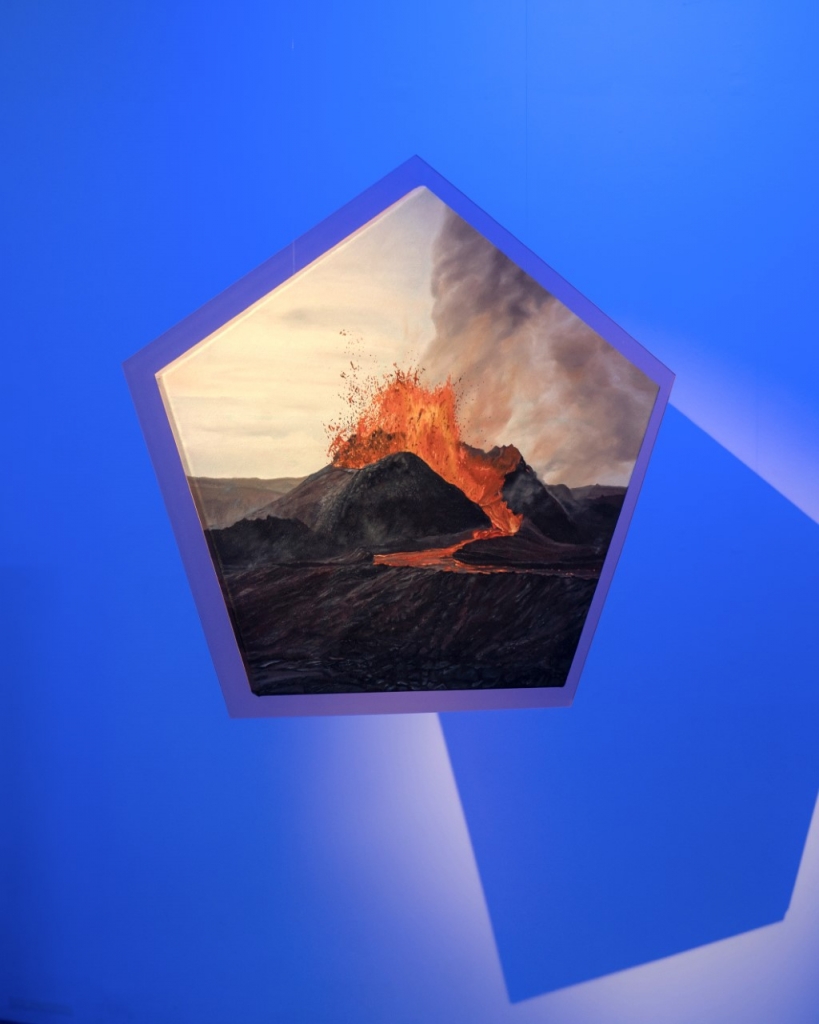
Alex Coma is an emerging artist from Granby, Quebec, currently residing in Montreal but soon to head off to Spain to work on other spiritual and artistic projects. After receiving his BFA from Concordia in 2014, he had a solo show at Livart in 2018, another AVE Gallery in 2019, among others. He has worked in painting, photography, sculpture, and installation. Coma’s work is diverse in scope, mysterious, dark and rich in mood, with a sense of expansive peace, hope, and transformational potential.
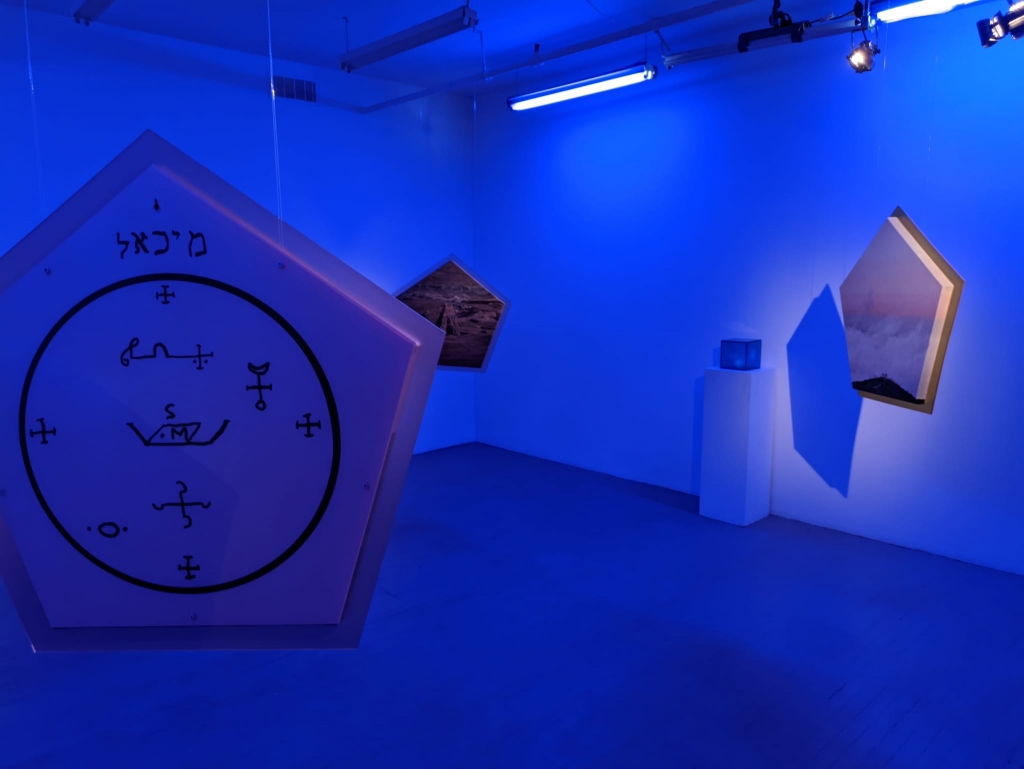
Near the entrance the gallery was a series of casually displayed sketches, Coma’s earlier works on paper, which appear to be automatic drawings on spiritual themes. He says these indicate his former self. The purpose of this ritual, to the artist, is to transform the intellect or personality, and the journey of the exhibition follows the ritual’s stages. Turning to the right, there is a large painting on unstretched dyed linen that consumes a corner of the gallery, lit up by projected fire. This is the opening segment of the ritual, in which the magician visualizes himself growing bigger than the earth, then the solar system, and eventually feeling the entire universe inside him. To the left is our massive sun, sending off a huge solar flare in the direction of the earth and moon, which are all painted to scale. Sacred geometry and the proportions of the planets in relation to each other are important to the artist, as well as the connection of the macrocosm of the cosmos to the microcosm of the human form. Before this fabric, a star lies on the ground upon a block, and upon the star is a burnt substance, perhaps an offering.
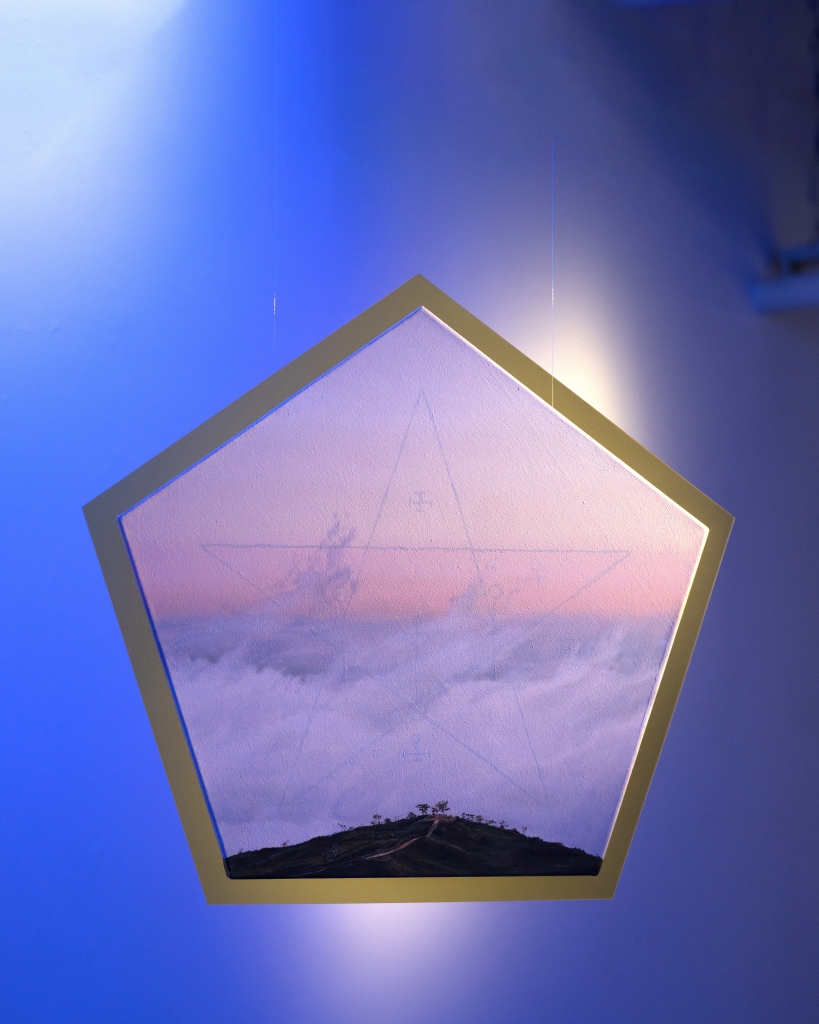
Tabula Rasa is an installation set up to reflect the ceremonial magic ritual called the Lesser Banishing Ritual of the Pentagram, originally created by the occult Order of the Golden Dawn, and one of the most widely used rituals used in western magic to this day. The configuration of the canvases are meant to aid in Coma’s spiritual practice, as this ritual is said by the artist to purify the intellect and the personality. The practitioner of this ritual traditionally positions themselves in orientation to each direction, draws a pentagram in the air as an act of cleansing and protection. The ritual also uses the Qabalistic cross, drawing on Jewish mysticism, and uses the names and sigils of the archangels which correspond to each element. Coma says that the paintings serve as a visualization aid to his spiritual practice.
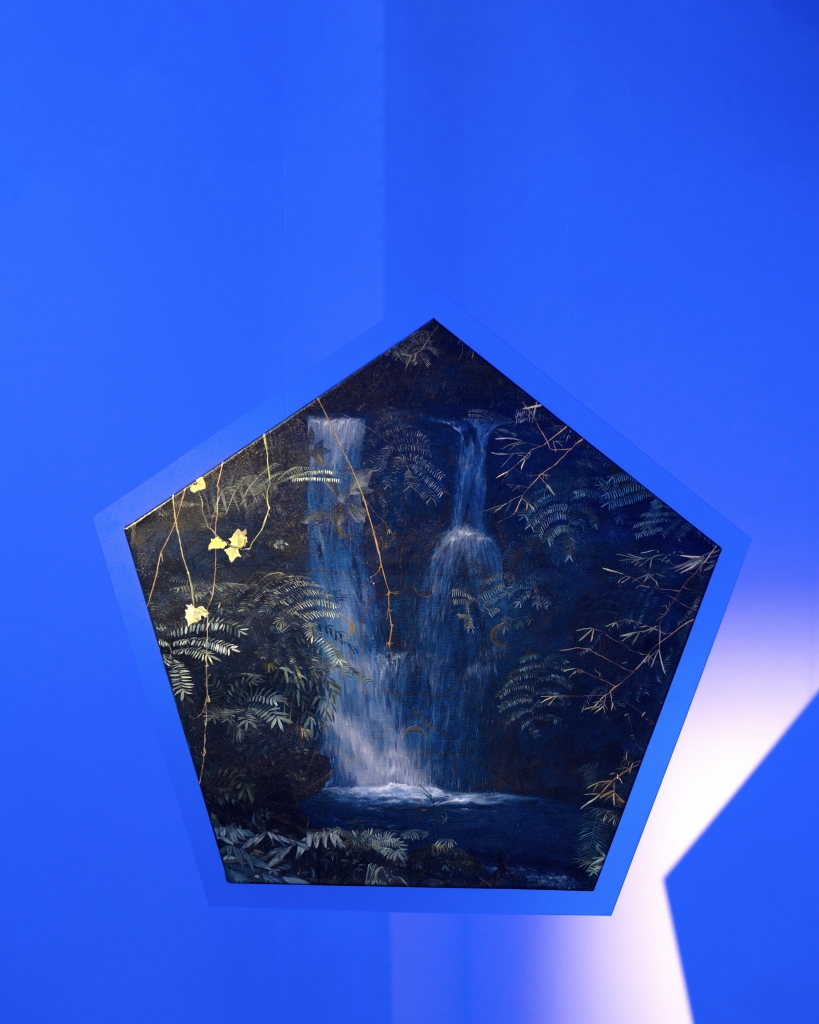
The purpose of this ritual is self-purification, protection, and ridding one’s environment of negative forces or energies. Each canvas represents a direction, and an element. For air, we have a pink sunrise or sunset landscape, seen from atop a mountain and just above wispy clouds. Representing water, we find a nocturnal scene of great delicacy with gentle waterfalls and tree branches and leaves. For fire, we see a dynamic erupting volcano painted in creamy yellows and smoky greys, with bold orange lava. Lastly, for earth, Coma has painted a desert landscape with a simple earthen temple, shaped something between a pyramid and an obelisk, with an entry door.
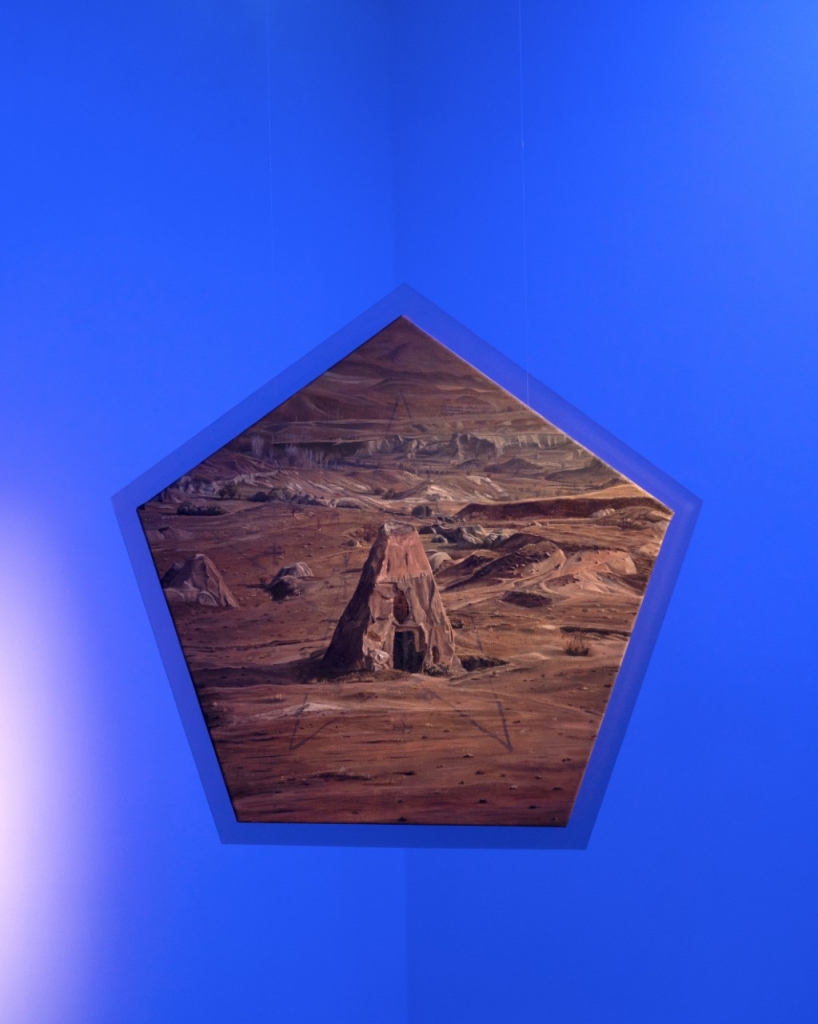
Other works that stand outside the sacred space of the hanging pentagons are a rendering of a man’s blue eye (presumably the artist’s eye surveying the scene), a figure of a woman rendered in an intuitive, outsider art style, which Coma says was done while connecting to his inner divine feminine. We can also find a blue plastic box inscribed with an eye and symbol of Aries (the astrological Sun sign of the artist).
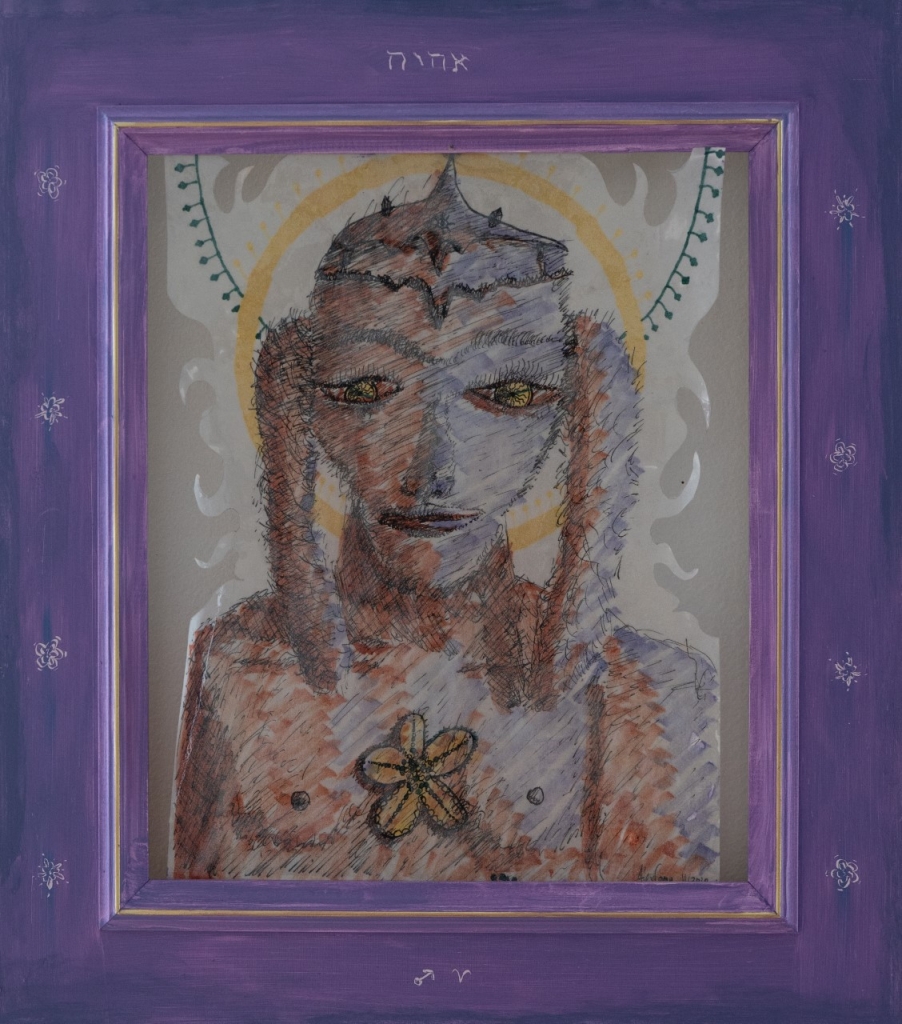
The strongest work in the show, to me, is one of Alex Coma’s spiritual landscapes, a detailed painting of a tower that resembles a mystical rocket, presiding over a seaside forest landscape. The style calls to mind landscape painters such as Hudson River painter Thomas Cole, or Constable, but it is considerably weirder and more intriguing. The tower is burning at its base, and appears to be futuristic in nature, with glass or metal beams but it also resembles the stone towers of a castle. At the top of the tower we see symbols such as a glowing crescent moon, a blue cube, and a six pointed star. This image calls to mind the Tower card of the Tarot, which signifies abrupt shifts and change, and the destruction that often devastates before the new can be formed. Quebec is a place that suffered at the hands of religion though the oppression of the church for a long time. As such, many in this province, intellectuals and artists especially, I have found, are atheists and scorn spirituality as well as religion as childish nonsense, or worse. It is refreshing to see a Quebecois artist such as Alex Coma bringing life into mystical themes and ideas, and showing that it is possible to explore such territories anew with fresh, young eyes, bringing us a sense of hope and possibility which we all need right now.
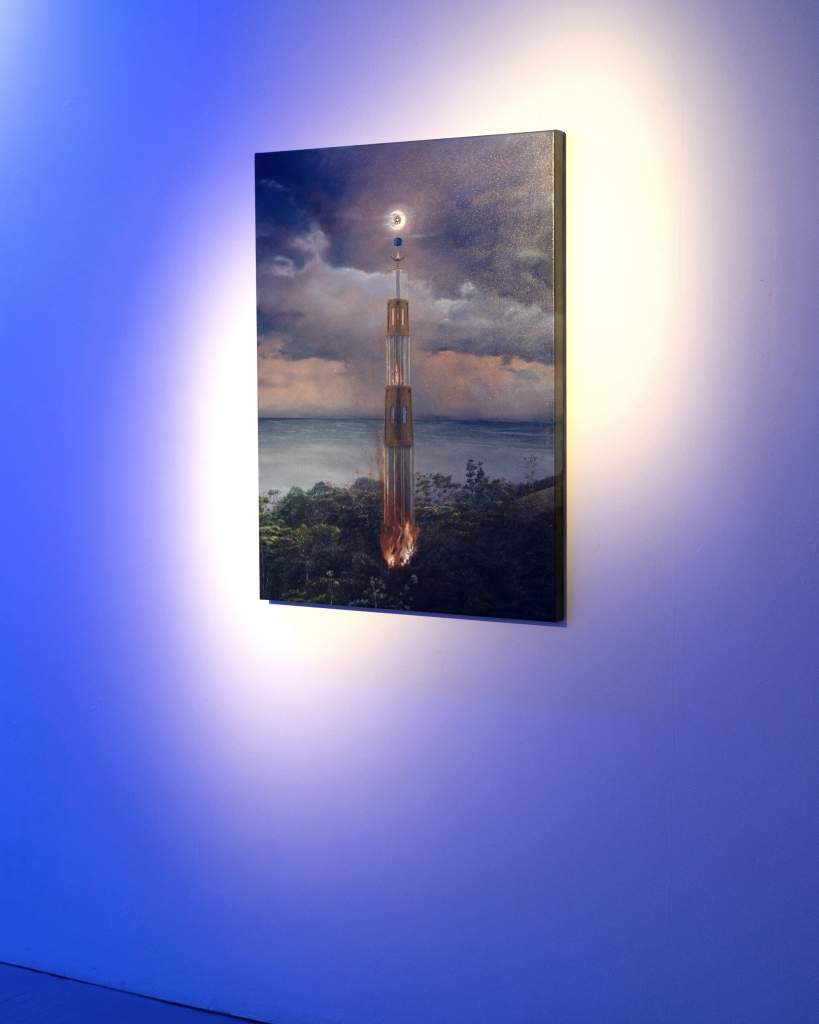
Alex Coma’s website can be found here
]]>
Featured image: Sarah Hatton at Visual Voice Gallery
1st Floor
Diss Torsion, space 122
https://disstorsion.com
5pm – 2am
2nd Floor
Espace 230, space 230
www.espace230.com
5pm – 1am
Le Gobelin d’argent, space 216
https://silvergoblin.cards/
5pm – 1am
3rd Floor
Studio 303, space 303
www.studio303.ca
9pm – 1am
Centre des arts actuels Skol, space 314
www.skol.ca
5pm – 1am
Luis Fernando Suarez, space 325
5pm – 1am
Shauna Roberts Dance, space 330
http://shaunarobertsdancecenter.com
5pm – 3am
4th Floor
Galerie Laroche Joncas, space 410
www.larochejoncas.com
5pm – 9pm
Galerie La Castiglione, space 416
www.lacastiglione.ca
5pm – 10pm
Galerie Luz, space 418
www.galerieluz.com
8pm – midnight
Visual Voice Gallery, space 421
www.visualvoicegallery.com
6pm – midnight
Circa Art Actuel, space 444
www.circa-art.com
5pm – 9pm
5th Floor
SBC Galerie d’art contemporain, space 507
www.sbcgallery.ca
8pm – midnight
]]>
J’éprouve le silence des corps, c’est doux les gestes inanimés
January 18 – March 2, 2019
Galerie B-312
The practices of two Lyon-based artists, Caroline Saves and Benoît Vidal, have come together seamlessly for this exhibition. Their large array of works use the floors, walls, windows, and ceiling of Gallery B-312 to create the effect of one large interconnected installation. Their muted colour palette is tied to the gallery’s white walls, grey floors, and blueish daylight. At times, the gallery seems like a workspace at a perfect standstill, where plans are being sketched and materials have been placed aside for a moment: gloves on a windowsill, words and shapes chalked out on the floor. The space is filled with the tension between playfulness and gravity as one symbol, the hand, subtly directs our path through the show. Fuzzy gloves reach for, grip, and touch one another. Photographs of disembodied hands are encased in a felt frame, a pillow. The gestural language that is being explored here is communicated through such satisfying textures and materials familiarly soft or smooth, making the experience of the show a sensual one. At the same time, long, winding lengths of plastic or deflated bags are unsettling within this hyper-bodily atmosphere – they become unnaturally long arms, lifeless limbs. Vidal’s videos document his process, somehow accentuating the installation’s eerie disembodied quality as the things he has touched take on a life of their own outside the screen. Saves’ style is recognizable throughout in the use of suspension and strong choice of materials. In her unique pairings, familiar items morph into something entirely new. Saves and Vidal’s residency undoubtedly blended their respective expertise, producing works with a comforting and disquieting presence that lingers and lingers.
This show is part of the Conversations: Montreal/Lyon project which includes another Belgo Building gallery (Arprim, centre d’essai en art imprimé) and two other Montreal galleries (La Vitrine and Diagonale). It runs until March 2, 2019.
Les centres dâ€ artistes et les galeries dâ€
artistes et les galeries dâ€ art contemporain du Belgo ont le plaisir dâ€
art contemporain du Belgo ont le plaisir dâ€ annoncer la cinquième édition de la Soirée Belgo, le jeudi 5 octobre de 17 h à 22 h.
annoncer la cinquième édition de la Soirée Belgo, le jeudi 5 octobre de 17 h à 22 h.
Encore une fois, ce rassemblement convivial vous permettra dâ€ apprécier le dynamisme de ce lieu centenaire. Pôle important de lâ€
apprécier le dynamisme de ce lieu centenaire. Pôle important de lâ€ art contemporain depuis de nombreuses années, le Belgo est, encore aujourdâ€
art contemporain depuis de nombreuses années, le Belgo est, encore aujourdâ€ hui, le seul lieu où il est possible de visiter autant
hui, le seul lieu où il est possible de visiter autant
de centres dâ€ artistes et de galeries dâ€
artistes et de galeries dâ€ art contemporain à une seule et même adresse au centre-ville.
art contemporain à une seule et même adresse au centre-ville.
Profitez des visites guidées, en français à 18h30 et en anglais à 20 h, pour entendre lâ€ histoire singulière du Belgo et connaître les différents lieux dâ€
histoire singulière du Belgo et connaître les différents lieux dâ€ exposition qui lâ€
exposition qui lâ€ animent! Le départ des visites se fera dans le hall, au rez-de- chaussée. Toutes les portes seront
animent! Le départ des visites se fera dans le hall, au rez-de- chaussée. Toutes les portes seront
grandes ouvertes pour vous faire découvrir la riche offre culturelle qui se cache dans cet édifice au cœur du Quartier des spectacles.
Coordonnées et accès : 372, rue Sainte-Catherine Ouest, Métro Place-des- Arts, sortie
de Bleury Sud. Accessible aux personnes à mobilité réduite et en fauteuil roulant.
Join us for La soirée Belgo!
The artist-run centres and the contemporary art galleries of the Belgo are pleased to announce the fifth edition of La soirée Belgo, on Thursday, October 5th from 5 to 10 p.m.
Once again, this friendly gathering will highlight the dynamic nature of this hundred-years-old building. As an important axis in contemporary art for many years, the Belgo continues to be the only place in the city where so many galleries and artist-run centres can be visited at a single address in Montrealâ€ s downtown area.
s downtown area.
Guided tours will be offered, in French at 6:30 p.m and in English at 8:00 p.m, to know more about the buildingâ€ s history and its tenants, vibrant art spaces eager to show you the rich cultural life of the Belgo, at the heart of Quartier des spectacles ! The visits will start in the hall, on the ground floor.
s history and its tenants, vibrant art spaces eager to show you the rich cultural life of the Belgo, at the heart of Quartier des spectacles ! The visits will start in the hall, on the ground floor.
Directions and accesibility : 372 Ste-Catherine St. West, Place-des- Arts Metro station,
de Bleury exit. Accessible to people with reduced mobility or using a wheelchair.
Participants:
Atelier 230Â
Open Studio Artists
Recent works by Kara Williams & Max Wright
Arprim, centre dâ€ essai en art imprimé
essai en art imprimé
Home staging, modernités, charmes et sortilèges
Jacinthe Loranger
+
Posture / Imposture
Marilyn Farley (espace Magasin)
Galerie B-312
Profile
Artie Vierkant
Other Hauntings: A Geography Beloved
Jin-me Yoon
Dans le cadre de Momenta | Biennale de lâ€ image
image
Commissaire invité : Ami Barak
La Castiglione
Open Passport
John Max
+
La maquette/livre photographique
Denis Farley, Myriam Gaumond, Lise Latreille, Isa Lausas, Louis Perreault et Normand Rajotte
CIRCA Art actuel
Exposition bénéfice 2017Â
Deux Poissons
This is Water / C’est de l’eau (2005-2016)
Patricia Walton
Galerie Dominique Bouffard
Rondes
François Vincent
Galerie Hugues Charbonneau
Performance via la caméra
Maria Hupfield et Lum-Desranleau
Dans le cadre de Momenta | Biennale de lâ€ image
image
Commissaire invité : Ami Barak
Galerie Laroche Joncas
This time around
Jean-Philippe Harvey
Galerie Luz
Krasi Dimtch, Dana Edmonds et Pierre Tousignant
Projet Pangée
The Far Off Blues Places
Anjuli Rathod + Vanessa Brown
SBC galerie d’art contemporain
Wood Land School : Kahatenhstánion tsi naâ€ tetiatere ne Iotohrkó:wa tánon Iotohrha /
tetiatere ne Iotohrkó:wa tánon Iotohrha /
Traçant des lignes de janvier à décembre
Quatrième geste des oeuvres de Billy-Ray Belcourt, Maggie Groat, Rita Letendre, Annie Pootoogook, Walter Scott, Joseph Tisiga, Charlene Vickers et Zotom.
Centre des arts actuels SkolÂ
Point de fuite
Kristi Ropeleski
+
Petites scènes videsÂ
Jean-Philippe Luckhurst-Cartier
Galerie Trois Points
Le point aveugle
Natascha Niederstrass
Programmation satellite de Momenta | Biennale de lâ€ image
image
Visual Voice Gallery
Dead Soon (Bientôt mort)
Gabriela Reyes Fuchs
Les Expositions Ymuno
Way of the Cross
Allen Ball
Petites incarnations (suite)
Centre des arts actuels SKOL
Du 6 mars au 22 avril 2017
« Je me demande comment honorer le travail à lâ€ atelier à une époque dâ€
atelier à une époque dâ€ hyper-connectivité et de vitesse. Lâ€
hyper-connectivité et de vitesse. Lâ€ atelier nâ€
atelier nâ€ est pas un espace acquis, trop souvent il persiste à nâ€
est pas un espace acquis, trop souvent il persiste à nâ€ être quâ€
être quâ€ un lieu précaire… Le travail est plus mobile, par les résidences de création, plus fluide, par les réalisations in situ. Pourtant la pratique dâ€
un lieu précaire… Le travail est plus mobile, par les résidences de création, plus fluide, par les réalisations in situ. Pourtant la pratique dâ€ atelier idéale demeure encore pour moi un espace sacré de concentration, un lieu de silence, voire dâ€
atelier idéale demeure encore pour moi un espace sacré de concentration, un lieu de silence, voire dâ€ extraction du monde autant quâ€
extraction du monde autant quâ€ un espace de rituels. Jâ€
un espace de rituels. Jâ€ ai ce désir de mettre à nu ces idées, comprenant les failles potentielles du processus, les moments dâ€
ai ce désir de mettre à nu ces idées, comprenant les failles potentielles du processus, les moments dâ€ hésitations… par lâ€
hésitations… par lâ€ incarnation du travail dans le corps et lâ€
incarnation du travail dans le corps et lâ€ espace réel, imaginaire et symbolique ».
espace réel, imaginaire et symbolique ».
— Barbara Claus
Dans son plus récent projet in situ, Petites incarnations (suite), actuellement présenté au Centre des arts actuels Skol depuis le 6 mars, lâ€ artiste montréalaise, Barbara Claus, travaille à même lâ€
artiste montréalaise, Barbara Claus, travaille à même lâ€ espace.
espace.
Au moyen dâ€ une dimension performative indirecte et dâ€
une dimension performative indirecte et dâ€ une instigation du lieu dâ€
une instigation du lieu dâ€ exposition, son processus demeure éminemment intime, voire réservé et privé. Lorsquâ€
exposition, son processus demeure éminemment intime, voire réservé et privé. Lorsquâ€ aucun visiteur nâ€
aucun visiteur nâ€ est dans la salle, elle intervient et quand un visiteur arrive, elle sâ€
est dans la salle, elle intervient et quand un visiteur arrive, elle sâ€ arrête et lâ€
arrête et lâ€ invite à enlever ses chaussures afin de le laisser entrer dans son « atelier ». Dâ€
invite à enlever ses chaussures afin de le laisser entrer dans son « atelier ». Dâ€ un voyage au Japon, Claus rapporte des coutumes culturelles et des influences diversifiées. La tradition japonaise veut que lâ€
un voyage au Japon, Claus rapporte des coutumes culturelles et des influences diversifiées. La tradition japonaise veut que lâ€ on se déchausse lorsque lâ€
on se déchausse lorsque lâ€ on entre dans un domicile, que ce soit chez soi ou chez quelquâ€
on entre dans un domicile, que ce soit chez soi ou chez quelquâ€ un dâ€
un dâ€ autre. Cette coutume ne se borne dâ€
autre. Cette coutume ne se borne dâ€ ailleurs pas quâ€
ailleurs pas quâ€ aux maisons et aux appartements, mais également à certains endroits publics, tels les musées et les galeries. En ce sens, deux possibilités sâ€
aux maisons et aux appartements, mais également à certains endroits publics, tels les musées et les galeries. En ce sens, deux possibilités sâ€ offrent au visiteur : il peut soit retirer ses chaussures et entrer à lâ€
offrent au visiteur : il peut soit retirer ses chaussures et entrer à lâ€ intérieur de lâ€
intérieur de lâ€ atelier immersif, soit sâ€
atelier immersif, soit sâ€ assoir sur un banc afin de contempler le tout de lâ€
assoir sur un banc afin de contempler le tout de lâ€ extérieur. Une division brute et non terminée délimite lâ€
extérieur. Une division brute et non terminée délimite lâ€ espace sacré de concentration, ce lieu de « rituels ».
espace sacré de concentration, ce lieu de « rituels ».
Lâ€ espace devient monographique. Lâ€
espace devient monographique. Lâ€ artiste lâ€
artiste lâ€ habite, se lâ€
habite, se lâ€ approprie et le transfigure par des codes symboliques. Dans celui-ci, elle travaille le rôle de la lenteur dans un monde où tout semble accélérer. Barbara Claus aborde maints thèmes, tels que la mémoire, lâ€
approprie et le transfigure par des codes symboliques. Dans celui-ci, elle travaille le rôle de la lenteur dans un monde où tout semble accélérer. Barbara Claus aborde maints thèmes, tels que la mémoire, lâ€ éphémérité et la mort. Sâ€
éphémérité et la mort. Sâ€ inscrivant dans un processus imbu dâ€
inscrivant dans un processus imbu dâ€ hésitations, entre construction et destruction, les traces apparaissent au moyen de détournements comme lâ€
hésitations, entre construction et destruction, les traces apparaissent au moyen de détournements comme lâ€ accumulation et le retrait de matières dissemblables. Le résultat est précaire puisque rien nâ€
accumulation et le retrait de matières dissemblables. Le résultat est précaire puisque rien nâ€ est permanent ; tout est momentané et spontané. Lâ€
est permanent ; tout est momentané et spontané. Lâ€ artiste va à lâ€
artiste va à lâ€ encontre de la pérennité et de la durabilité en travaillant à lâ€
encontre de la pérennité et de la durabilité en travaillant à lâ€ aboutissement de lâ€
aboutissement de lâ€ inabouti.
inabouti.
Dans la salle de Skol, quatre cloisons en perpétuelle évolution sâ€ enchainent. Le mur initial — Monument I — est tapissé de minces feuilles dâ€
enchainent. Le mur initial — Monument I — est tapissé de minces feuilles dâ€ aluminium superposées. Le mot « MORTE » y est creusé et parsemé de coruscations ; de distinctes réverbérations. La surface métallique reflète le mur parallèle — Monument II — qui est entièrement recouvert de cire dâ€
aluminium superposées. Le mot « MORTE » y est creusé et parsemé de coruscations ; de distinctes réverbérations. La surface métallique reflète le mur parallèle — Monument II — qui est entièrement recouvert de cire dâ€ abeille. Une succession de fines couches donne à la matière une couleur jaune saturé. Lâ€
abeille. Une succession de fines couches donne à la matière une couleur jaune saturé. Lâ€ odeur de miel est omniprésente.
odeur de miel est omniprésente.
À lâ€ opposé, par des Lignes de feu, Claus tente dâ€
opposé, par des Lignes de feu, Claus tente dâ€ imiter la technique utilisée dans ses livres dâ€
imiter la technique utilisée dans ses livres dâ€ artiste : le découpage dâ€
artiste : le découpage dâ€ entailles délicates, ensuite brulées. Alors que chaque imperfection fait intégralement partie du processus, des lignes horizontales évident le plâtre de la cloison. Sur la paroi adjacente — La ruine —, lâ€
entailles délicates, ensuite brulées. Alors que chaque imperfection fait intégralement partie du processus, des lignes horizontales évident le plâtre de la cloison. Sur la paroi adjacente — La ruine —, lâ€ artiste perfore dâ€
artiste perfore dâ€ innombrables petits trous et recouvre lâ€
innombrables petits trous et recouvre lâ€ entièreté de la surface de graphite. Le mot « RUINE » sâ€
entièreté de la surface de graphite. Le mot « RUINE » sâ€ y immisce, peint dâ€
y immisce, peint dâ€ un ton spéculaire. Ainsi, la multitude des textures, par différentes étapes, contribue à lâ€
un ton spéculaire. Ainsi, la multitude des textures, par différentes étapes, contribue à lâ€ état transitoire que Claus offre au visiteur.
état transitoire que Claus offre au visiteur.
Le 22 avril prochain, dernier jour du projet, un finissage et un démantèlement collectif sont prévus. Chaque passant partira avec un élément de ce cadre dâ€ extraction.
extraction.
Lâ€ évolution du travail de lâ€
évolution du travail de lâ€ artiste est disponible sur son site web.
artiste est disponible sur son site web.
HOUSEBOUND: Portraits from the Winter Garden
Galerie Trois Points
March 11 – April 22, 2017
The house plant possesses the cinematic ability to oscillate between the highly significant and the background prop. As a body of signification, the plant exists in relation to one individual: its caretaker. Even if a couple bought their asparagus fern together—taking turns carrying it on the walk home from the nursery, potting it on the first kitchen table that belonged to them and only them—only one half of the pair will remember to water it. It grows because of this individual, it makes it through the winter. As long as the fern is contained in a pot, in an apartment, in the middle of a city, its life is dependent. So the individual loves it, because he understands that it needs him. But the house plant can die, and the house plant is left behind, and the house plant is, of course, non-sentient.
The strange void that potted dracaena, fiddle leaf fig trees and philodendrons fill in our lives is explored by artists Evergon and Jean-Jacques Ringuette, with the exhibition HOUSEBOUND: Portraits from the Winter Garden, at Galerie Trois Points until April 22. The photographic works are an examination of interiority, reminiscence, and the beauty of the botany we keep.
A grid of 31 inkjet prints (3×10, plus one frame added to the top right corner) dominates the show. Brightly lit and placed in front of the same cool grey background, various potted plants sit for their portraits. One after the other, they are uniformly lined up like in an obligatory yearbook page for an aloof graduating class. They are a motley crew. “Margaret,†the bulbous and key lime green succulent, is slouching out of her tilted pot. “Echoâ€â€ s pink petals cascade whimsically from a tall glass vase, like the girl from the wealthy family who doesnâ€
s pink petals cascade whimsically from a tall glass vase, like the girl from the wealthy family who doesnâ€ t brush her hair. “Émilie†broods in a dark green tangle, at odds with the sunny yellow of the planter she crouches in. The camera captures the ridges of a vein, the glints of reflected light, and the vast negative space that respects each ‘lady-plantâ€
t brush her hair. “Émilie†broods in a dark green tangle, at odds with the sunny yellow of the planter she crouches in. The camera captures the ridges of a vein, the glints of reflected light, and the vast negative space that respects each ‘lady-plantâ€ as a subject. Within HOUSEBOUND, the exotic flora are yours for a moment. Without having to tend to their soil, it is possible to imagine complaining to “Margaret†about the morning rain or glancing in the hallway mirrorâ€
as a subject. Within HOUSEBOUND, the exotic flora are yours for a moment. Without having to tend to their soil, it is possible to imagine complaining to “Margaret†about the morning rain or glancing in the hallway mirrorâ€ s reflection of both you and “Echo†to check your teeth. You bring them the nourishment of the outside world; you are their caretaker. In return, they give you beautiful company.
s reflection of both you and “Echo†to check your teeth. You bring them the nourishment of the outside world; you are their caretaker. In return, they give you beautiful company.
Artist Evergon is also known as Celluloso Evergonni, Eve R. Gonzales and Egon Brut. The Canadian photographer is internationally acclaimed for his technological innovation (non-silver processes, electrostatic works and life-size holograms, for example) and thematic of sexuality, gender, aging and the body. A professor emeritus of studio arts at Concordia University, Evergon lives and works in Montreal. His work has been shown from Los Angeles to Shanghai, but, in recent years, Evergonâ€ s health has rendered him housebound. The exhibition is a collaboration with former student, friend and model Jean-Jacques Ringuette, capturing living things that only live indoors. The creative partnership may be symbiotic in the same way that a plant and its human individual are. When art is made, is this not a form of photosynthesis?
s health has rendered him housebound. The exhibition is a collaboration with former student, friend and model Jean-Jacques Ringuette, capturing living things that only live indoors. The creative partnership may be symbiotic in the same way that a plant and its human individual are. When art is made, is this not a form of photosynthesis?
The show also features a series of memento mori-style still-life prints. Unlike the rich, natural colors of the house plants, the still lifes conjure fleshy decay. At luncheons where meat is served, it sits on a platter as the centerpiece of the table. After the lunch guests are full and float on to the next room, while the unfinished carcass is neglected. Purposeless, its death is consummated. The flowers of these visually opulent images are browning, their petals brittle and tendrils wilted. The crowded frames feature water-damaged photographs, bronze amphibian figurines and a model skeleton. Glittering red rubies of DayQuil and cherry tomatoes are scattered on the table, posing the question: ‘what does one do to feel well?â€ . The scene suggests the simultaneous existence of the living, the already-lived, and the intangible nostalgia for life itself. As a testament to expiration, these still-lifes subscribe to the more cynical ontology of the house plant: it is painfully perishable.
. The scene suggests the simultaneous existence of the living, the already-lived, and the intangible nostalgia for life itself. As a testament to expiration, these still-lifes subscribe to the more cynical ontology of the house plant: it is painfully perishable.
From sunny windowsills and forgotten dentist office corners, plants extend stems of companionship, whispering to its caregiver. Evergonâ€ s Winter Garden reminds viewers to water, resoil and tend to these symbols of how marvellous life is while it is still living.
s Winter Garden reminds viewers to water, resoil and tend to these symbols of how marvellous life is while it is still living.


